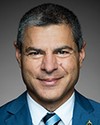Good morning, and thank you very much, Madam Chair and committee members. You should have my notes in a little package in front of you as to what the UAS CE is all about, but I'll present it here as well.
I'm pleased to present this morning and I would like to thank you very much for this opportunity. My name is Marc Moffat. I'm the director general of the UAS CE, located in Alma, Quebec, and co-located with 3 Wing Bagotville. I've also had the pleasure of serving with the military for 20 years in the air force.
First off, let me provide a few words on our organization and what we have accomplished to date in support of the Canadian UAS community. Established in 2011, the UAS CE, or Centre d'excellence sur les drones, has been committed to support of the UAS community and its development. The site has been supported by the City of Alma and its council.
The UAS CE is a non-profit organization whose mission is to develop a centre of expertise, services in innovation and design, applications, and UAS operation, but most specifically to support the safe integration of UAS in our Canadian airspace.
The City of Alma has the humble pretension to state that the UAS CE test site was established even before the Federal Aviation Administration created the six American sites.
The UAS CE has more recently been highlighted in the updated Quebec aerospace strategy, 2016-26. The Quebec government has agreed to invest in two specific areas. First, the UAS CE will be heading the establishment of a UAV cluster that will be mandated to provide some strategic orientation to the Quebec aerospace sector. Second, the government has agreed to invest $800,000 in infrastructure for the establishment of a pre-qualification and training site. This pre-qualification test site represents a potential investment of $2.5 million. It could then become one of its kind in North America.
Concerning operations, infrastructure, and airspace, the UAS CE's location and co-operation with 3 Wing Bagotville has made it possible to conduct, for example, medium altitude, long endurance, or MALE, UAS operations in segregated and non-segregated airspace. We have supported the operation of a 45-foot wingspan UAV, flying more than 160 kilometres from the Alma airport at altitudes over 15,000 feet.
More recently, Transport Canada has approved the establishment of eight areas of class F restricted airspace to conduct UAV operations. Most specifically, these zones are critical to the beyond visual line of sight operations. These operations represent the next critical step for UAS development in Canada.
The UAS CE is also the co-founder of the International Consortium of Aeronautical Test Sites, or ICATS. The first international organization of its kind, the consortium supports the industry by enabling the development and testing of UAVs. ICATS was created to share information between the members on operational safety, flight regulations, and when allowed to do so, actual operational experience.
The UAS CE and its approximately 20 members, which are from universities and colleges and private industry, have developed very specific and exclusive expertise. The centre has participated in multiple round table discussions, conferences, and other events related to the sector and would like to offer the following observations.
On regulation development, the proposed regulations for the UAS under 25 kilograms within line of sight profile appear to provide the appropriate framework and have been supported by the community at large. However, the timelines have continued to slip to the right and have, in my opinion, resulted in numerous illegal operations, since the SFOC process has been too slow to cope with the demand. I'm fairly certain that the community will agree on that point.
On recognition of and support for a national test site, we need hands-on participation and involvement from Transport Canada. For your information, so far, there have been two test sites established in Canada: one in Foremost, Alberta—I'm not too sure if they've been invited to speak—and ourselves. We have received Transport Canada's support in the establishment of restricted airspace, and we believe it has strong interest in participating in the development and the operation of BVLOS operations. However, to date, we have been treated as any other operators.
Some provinces, such as Alberta and Quebec, have committed time and money to present strategic orientation. There is an urgent requirement or need to provide some strategic guidance at the federal level as well. I believe it would have a positive influence on the overall development of regulations.
As for standardization across all regions, as I stated, although regulations are being adapted to provide a safe framework, there is a wide gap between regions when it comes to its application. The SFOC application process is different across all regions and this is an issue that needs to be addressed.
On awareness, Transport Canada appears to have some concern with respect to the number of incidents related to UAS. However, I strongly believe that this increased number of statistics is driven by a lack of knowledge from recreational users. I think we've talked about that in the previous segment.
In conclusion, I'd like to thank you very much for this opportunity. I'm looking forward to answering any questions you might have, in French as well.



